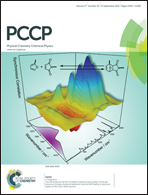Magnetic anomalies and itinerant character of electrochemically Li-inserted Li[Li1/3Ti5/3]O4†
Abstract
Spinel oxides of Li[LiyTi2−y]O4 with 0 ≤ y ≤ 1/3 exhibit two desirable features for solid state chemistry and condensed matter physics. One is a reversible lithium insertion/extraction reaction, in particular for Li[Li1/3Ti5/3]O4, and the other is a superconducting transition at Tc ≃ 13 K for Li[Ti2]O4. To study the change in magnetic environments of the y = 1/3 compound with excess Li(x), we measured the magnetic susceptibility (χ) for the Li1+x[Li1/3Ti5/3]O4 samples with 0 ≤ x ≤ 0.95, which were prepared by an electrochemical Li insertion reaction into Li[Li1/3Ti5/3]O4. Even for the x = 0 sample, two magnetic anomalies were found at Tonm1 (=63 K) and Tonm2 (=21 K), despite the fact that all Ti ions should be in the 4+ state with S = 0. A comparative study of TiO2 and Li2TiO3 revealed that these magnetic anomalies are not impurity-induced effects but are caused by an intrinsic nature of Li[Li1/3Ti5/3]O4, probably due to either slight compositional deviation from stoichiometry or dislocations such as a Magnéli phase. For the x > 0 samples, the χ vs. temperature curve was found to consist of a temperature-independent Pauli-paramagnetic contribution and a Curie–Weiss contribution. Detailed analyses of χ clarified the systematic variations of the effective magnetic moment of Ti ions, effective mass of electrons in the conduction band, and density of states at the Fermi level with x, indicating that the Li+ ions at the 16d site play a significant role in localizing d electrons of Ti3+ ions.
![Graphical abstract: Magnetic anomalies and itinerant character of electrochemically Li-inserted Li[Li1/3Ti5/3]O4](/en/Image/Get?imageInfo.ImageType=GA&imageInfo.ImageIdentifier.ManuscriptID=C5CP02999F&imageInfo.ImageIdentifier.Year=2015)

 Please wait while we load your content...
Please wait while we load your content...